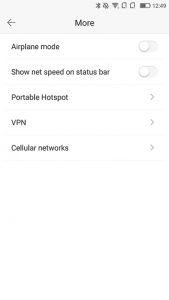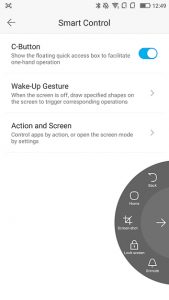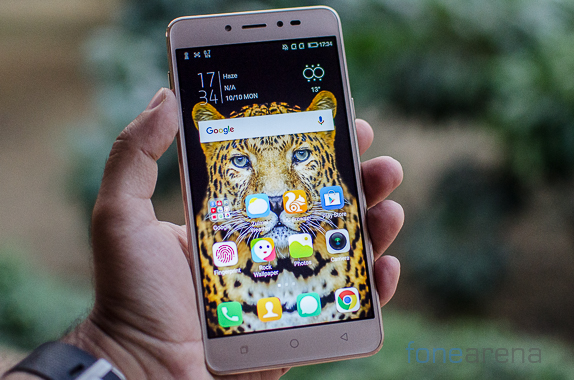 In the highly competitive entry level Android device market, Coolpad has managed to carve out a niche for itself. From the Note 3 to the Mega, each device has promised and for the most part delivered a great balance between price and performance. Yes, there have been a fews misses along the way but once again with the launch of the Coolpad Note 5, it looks like they might have a winner on their hands that can finally give stiff competition to a market mostly dominated by the likes of Xiaomi’s Redmi series.
In the highly competitive entry level Android device market, Coolpad has managed to carve out a niche for itself. From the Note 3 to the Mega, each device has promised and for the most part delivered a great balance between price and performance. Yes, there have been a fews misses along the way but once again with the launch of the Coolpad Note 5, it looks like they might have a winner on their hands that can finally give stiff competition to a market mostly dominated by the likes of Xiaomi’s Redmi series.
Coolpad Note 5 specifications
- 5.5-inch (1920 x 1080 pixels) Full HD fully laminated display, scratch-resistant glass for protection
- 1.5GHz Octa-Core Snapdragon 617 processor with Adreno 405 GPU
- 4GB RAM, 32GB internal memory, expandable memory up to 64GB with microSD
- Hybrid Dual SIM (nano+nano/microSD)
- Android 6.0.1 (Marshmallow) with Cool UI 8.0
- 13MP rear camera with dual LED flash, 5P lens, f/2.2 aperture, CMOS sensor, 1080p video recording
- 8MP front-facing camera, f/2.2 aperture, 80.1-degree wide-angle lens, LED flash
- Fingerprint sensor
- Dimensions: 152×75.7×8.85mm; Weight: 173.4g
- 4G VoLTE, WiFi 802.11 b/g/n, Bluetooth 4.0, GPS, USB OTG
- 4010mAh battery
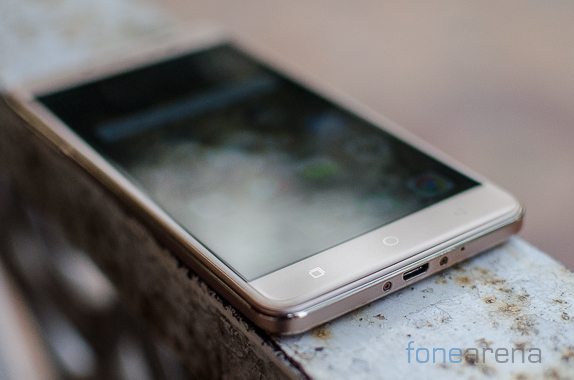
Up front is the 5.5 inch Full HD laminated display that is flanked by not so insignificant bezels. The laminated display has a scratch resistant glass layer on top that gently tapers on all sides. No, the screen isn’t curved but the tapered edges make the phone a lot more comfortable to hold. Above the screen lies the 8MP front facing camera alongside an LED flash that should help users take better selfies in low light conditions. More on that in the camera section though. The Coolpad Note 5 represents a return to capacitive buttons below the screen. We personally prefer having the separate capacitive buttons as it clears out more screen real estate but it’s mostly a personal preference.
A metallic rim runs around the body of the phone with curved edges on both sides. These aren’t entirely chamfered edges but certainly do add an element of design. The power button is placed higher up over on the right but tends to be a bit sticky by design. A single volume rocker lies on the left side and offers sufficient give. The headphone jack is placed along the top edge while the microUSB charging port is lined up along the bottom edge. Ergonomically, the phone is well designed and despite the larger dimensions of a phone with a 5.5 inch display, it manages to fit well in the hand.
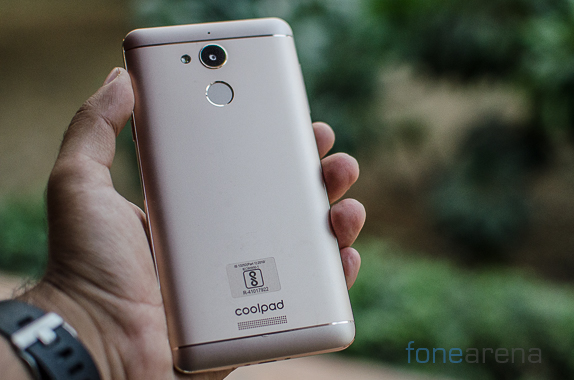 Flip the Coolpad Note 5 over to the back and you can see the metal back of the phone. The design here is somewhat generic and draws inspiration from a whole host of hardware. Antenna bands at the top and bottom segregate the plastic end caps from the metallic back panel. A 13MP camera island sits proud of the back of the phone and is hence prone to scratches. Next to it is the dual LED flash. Following modern design trends, the circular fingerprint scanner placed below the camera module is the exact size as the camera. The fingerprint scanner remains active even when the screen is off so you can simply tap on it to unlock your phone. The module works really well as far as fingerprint readers go and there was no sense of lag in unlocking your device using the protection method.
Flip the Coolpad Note 5 over to the back and you can see the metal back of the phone. The design here is somewhat generic and draws inspiration from a whole host of hardware. Antenna bands at the top and bottom segregate the plastic end caps from the metallic back panel. A 13MP camera island sits proud of the back of the phone and is hence prone to scratches. Next to it is the dual LED flash. Following modern design trends, the circular fingerprint scanner placed below the camera module is the exact size as the camera. The fingerprint scanner remains active even when the screen is off so you can simply tap on it to unlock your phone. The module works really well as far as fingerprint readers go and there was no sense of lag in unlocking your device using the protection method.

We really like what Coolpad is doing with the Note 5 on the design front. The front fascia of the hardware is subdued yet manages to look great. The back on the other hand is derivative but the gently curved corners ensure it fits well in the hand. The phone measures 152×75.7×8.85mm and with a weight of 173.4g, the heft feels suitably premium without being too heavy.
Software
Built on Android 6.0.1, the phone runs a custom skin called Cool UI. Now in it’s 8th revision, there’s some interesting features thrown in for good measure.
Pressing the power button drops you into a lockscreen or password protected area in case you are using the latter. This, like most of the UI, is very similar to how most other phones operate. The lockscreen displays the time and date in the bottom left corner with a swipe based shortcut to the camera app located on the right. Up top is where all the notifications show up. A somewhat cool addition is the way the wallpaper zooms in when you unlock the device creating an illusion of depth. Another nifty addition is that the keypad defaults to a smaller size with right alignment, something that should make it easier for the majority of users to quickly access it.
Once you’ve swiped in to the homescreen, you’ll observe that the phone adopts a single layer interface. Eschewing the app drawer, all apps are placed front and center on the home screen itself. Long press anywhere on the homescreen and you’ll be able to add widgets, set any panel as the primary screen. Other customizations include the ability to change the transitions between display panels. We like that Coolpad has gone out of their way to build features that let you really customize your experience. From the homescreen grid layout to the allowing for a looping home screen, there’s a lot of options here and most users won’t feel the need to install a third party launcher. This is further compounded by the fact that the interface and software in general is very well optimized and tends to run extremely smoothly. Throughout our testing period, we failed to witness any lag or dropped framerates in the interface and general UI.
Diving into the software feature-set, there are some niceties like the ability to display your connection speed in the status bar. An auto run manager built into the software lets you control what apps can or cannot run at launch. Following the feature introduction in MIUI, the Dual Apps feature in the Coolpad Note 5 also allows you to maintain multiple Facebook & WhatsApp accounts.
Also seeing an introduction is a floating C button that provides quick access to oft used actions like the homescreen, screenshots and more. In a large screen device like the Note 5, having one handed control over at least some functionality goes a long way. A multitude of screen based gestures are also integrated into the software.
A number of apps like UC Browser, Zuimei Weather, WPS Office and more come pre-installed on the hardware, something we really wish wasn’t the case. All said and done, Coolpad has done a pretty job on the software optimization front but anyone expecting a stock like experience is going to be sorely disappointed. This is a highly customized version of Android and for the most part, we wouldn’t expect much in terms of software updates. That said, the Coolpad Note 5 does have support for OTA software updates.
Performance
The Coolpad Note 5 is powered by a 1.5GHz Octa-Core Snapdragon 617 processor paired with an Adreno 405 GPU. Now, the Snapdragon 617 is not quite the newest or fastest chipset around and with the Xiaomi Redmi Note 3 being powered by the superior Snapdragon 650 chipset, you’d be tempted to drop the handset from your consideration. Where the Coolpad Note 5 loses out in terms of sheer performance, it is still a very well optimized piece of hardware that enables an above average usage experience. With 4GB of RAM onboard, we observed the multitasking experience to be extraordinary. We had no trouble running multiple games, apps and easily switching between them.The extended RAM is more evident in day to day usage and positively augments the general experience. We noticed that the phone marginally heats up when playing games or CPU intensive apps but not to a degree that would cause discomfort. Though synthetic benchmarks aren’t the most ideal way to gauge a phone’s performance, we’ve included a few below to give you a better idea of comparative performance.
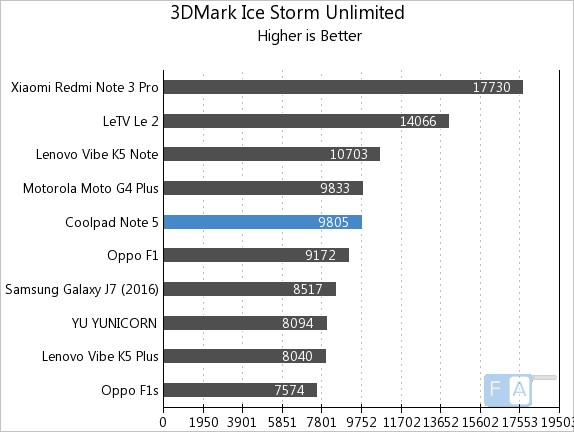
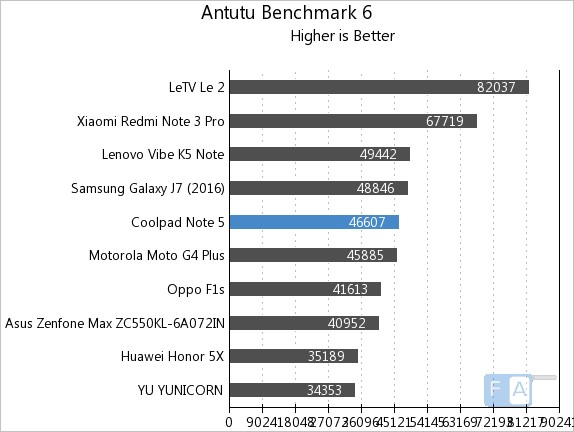
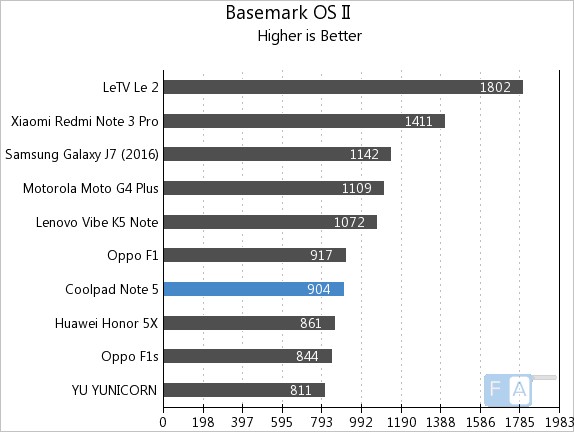
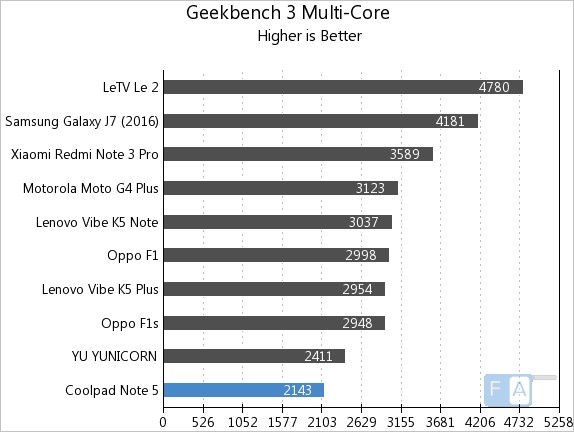
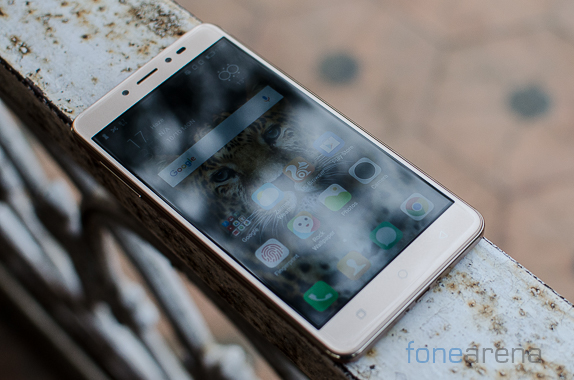
Brightness levels go particularly high and there’s absolutely no issue with viewing the screen outdoors in sunlight. The display comes calibrated to be just slightly oversaturated, the way that most users would prefer it. Unfortunately, there is no way to tweak the warmth levels of the display.
Camera
In terms of camera specifications, there’s a 13MP rear module with a dual LED flash. The camera has a 5P lens, f/2.2 aperture which means that you should temper your expectations for low light performance.
The camera interface provides for a Pro Mode that allows for a modicum of control over your shots. There’s also a Beauty mode that smoothes out the contours of the skin to make images more visually appealing. We’d recommend staying away from this mode though as it imparts a very unnatural hue to the shots. In addition, there’s of course the regular photo mode. Diving into settings let you switch resolutions between a 13MP 4:3 mode, 10MP 16:9 and a 10MP 1:1 mode. The sensor has a native aspect ratio of 4:3 because of which it crops in when you switch to the 10MP 16:9 mode.
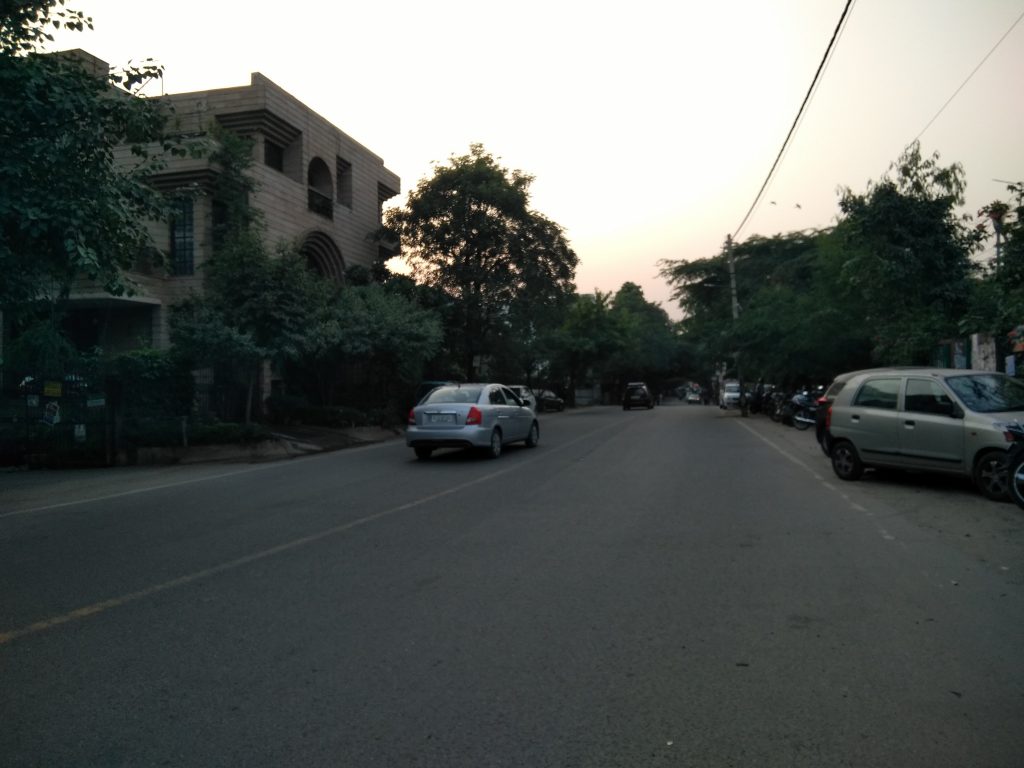 We were less than enthused about the image quality from the Coolpad Note 5. With every progressive generation, we see a manner of deterioration in image quality and on the Note 5, photographs are generally low on details and have a certain hue to them that makes them anything but accurate. Even in bright light, the phone struggled with dynamic range making the camera rather disappointing.
We were less than enthused about the image quality from the Coolpad Note 5. With every progressive generation, we see a manner of deterioration in image quality and on the Note 5, photographs are generally low on details and have a certain hue to them that makes them anything but accurate. Even in bright light, the phone struggled with dynamic range making the camera rather disappointing.
In terms of video capabilities, users can shoot in 1080p, 720p and 480p resolutions. There is of course no 4K support here and video even in lower resolution is mostly unusable. Extreme compression means that video looks really grainy and low on details. This extends to the front facing camera which takes very un-remarkable photos. Switching off the beauty mode helps to a degree but not enough to salvage the shot.
Connectivity & Battery Life
Connectivity options on the handset are par for the course. Between 4G & VoLTE, WiFi 802.11 b/g/n, Bluetooth 4.0 and GPS, you get feature parity with most other phones in the category. Xiaomi’s phones stand out in comparison due to the presence of an IR port that can be used to control consumer electronics around the house. Of the 32GB of built in storage, there’s approximately 21GB available at launch. While the phone does include the ability to expand storage, it is by means of a Hybrid SIM slot which essentially means that you have to give up on Dual SIM capabilities to be able to expand storage. The other option is to use USB OTG to add further storage.
The Coolpad Note 5 with it’s 4010mAh battery performs extremely well in terms of battery life. We consistently observed almost two days of battery life with average usage. With multiple email accounts, a couple of phone calls and extensive social media usage, it would still be very hard to run the battery down by the end of the day. For a large number of people, the Coolpad Note 5 should easily deliver over a day of usage. The phone’s battery of course is non removable and we find it a bit unfortunate that the phone still charges over microUSB. The presence of a USB Type C connector could have served as yet another way to differentiate the handset.
Conclusion
The Coolpad Note 5 serves as a reminder of how far technology has come. Between the high quality Full HD display, 4GB of RAM and ensuing performance in addition to the attention to design are all hallmarks of premium handset. To deliver these features at a price point of Rs. 10,999 indicates the rapid commoditization of technology.

Certain compromises have been made of course, especially on the camera front. We really wish that the Note 5 was capable of taking better images which would have made it a sure shot recommendation from us. Additionally, a newer CPU would have gone a long way in assuaging prospective consumer’s fears over long term usability. All said and done though, Coolpad has done a pretty neat job of delivering a product that is very well balanced for the most part.
Pros
- Great design
- Good display
- Excellent battery life
Cons
- Specifications aren’t very competitive
- Below average camera quality








